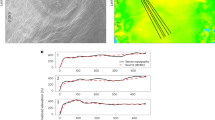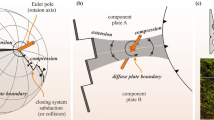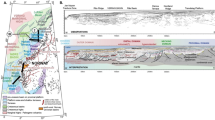Abstract
The Gamburtsev Subglacial Mountains are the least understood tectonic feature on Earth, because they are completely hidden beneath the East Antarctic Ice Sheet. Their high elevation and youthful Alpine topography, combined with their location on the East Antarctic craton, creates a paradox that has puzzled researchers since the mountains were discovered in 19581. The preservation of Alpine topography in the Gamburtsevs2 may reflect extremely low long-term erosion rates beneath the ice sheet3, but the mountains’ origin remains problematic. Here we present the first comprehensive view of the crustal architecture and uplift mechanisms for the Gamburtsevs, derived from radar, gravity and magnetic data. The geophysical data define a 2,500-km-long rift system in East Antarctica surrounding the Gamburtsevs, and a thick crustal root4 beneath the range. We propose that the root formed during the Proterozoic assembly of interior East Antarctica (possibly about 1 Gyr ago), was preserved as in some old orogens5,6 and was rejuvenated during much later Permian (roughly 250 Myr ago) and Cretaceous (roughly 100 Myr ago) rifting. Much like East Africa7, the interior of East Antarctica is a mosaic of Precambrian provinces affected by rifting processes. Our models show that the combination of rift-flank uplift, root buoyancy and the isostatic response to fluvial and glacial erosion explains the high elevation and relief of the Gamburtsevs. The evolution of the Gamburtsevs demonstrates that rifting and preserved orogenic roots can produce broad regions of high topography in continental interiors without significantly modifying the underlying Precambrian lithosphere.
This is a preview of subscription content, access via your institution
Access options
Subscribe to this journal
Receive 51 print issues and online access
$199.00 per year
only $3.90 per issue
Buy this article
- Purchase on Springer Link
- Instant access to full article PDF
Prices may be subject to local taxes which are calculated during checkout




Similar content being viewed by others
References
Sorokhtin, O., Avsyuk, G. Y. & Koptev, V. I. Determination of the thickness of the ice cap in East Antarctica Inform . Bull. Soviet Antarctic Expedition 11, 9–13 (1959)
Bo, S. et al. The Gamburtsev Mountains and the origin and early evolution of the Antarctic Ice Sheet. Nature 459, 690–693 (2009)
Cox, S. E. et al. Extremely low long-term erosion rates around the Gamburtsev Mountains in interior East Antarctica. Geophys. Res. Lett. 37, L22307 (2010)
Hansen, S. E. et al. Crustal structure of the Gamburtsev Mountains, East Antarctica, from S-wave receiver functions and Rayleigh wave phase velocities. Earth Planet. Sci. Lett. 300, 395–401 (2010)
Fischer, K. M. Waning buoyancy in the crustal roots of old mountains. Nature 417, 933–936 (2002)
Leech, M. L. Arrested orogenic development: eclogitization, delamination and tectonic collapse. Earth Planet. Sci. Lett. 185, 149–159 (2001)
Petit, C. & Ebinger, C. Flexure and mechanical behavior of cratonic lithosphere: gravity models of the East African and Baikal rifts. J. Geophys. Res. 105, 19151–19162 (2000)
Boger, S. D. et al. Pan-African intraplate deformation in the northern Prince Charles Mountains, East Antarctica. Earth Planet. Sci. Lett. 195, 195–210 (2002)
Veevers, J. J., Saeed, A. & O'Brien, P. E. Provenance of the Gamburtsev Subglacial Mountains from U–Pb and Hf analysis of detrital zircons in Cretaceous to Quaternary sediments in Prydz Bay and beneath the Amery Ice Shelf. Sedim. Geol. 211, 12–13 (2008)
Ritzwoller, M. H., Shapiro, N. M., Levshin, A. L. & Leahy, G. M. Crustal and upper mantle structure beneath Antarctica and surrounding oceans. J. Geophys. Res. 106, 30,645–30,670 (2001)
Fitzsimons, I. C. W. in Proterozoic East Gondwana: Supercontinent Assembly and Breakup (eds Yoshida, M., Windley, B. F. & Dasgupta, S. ) 93–103 (Geol. Soc. London, 2003)
Veevers, J. J. Case for the Gamburtsev Subglacial Mountains of East Antarctica orginating by mid-Carboniferous shortening of an intracratonic basement. Geology 22, 593–596 (1994)
Sleep, N. H. Mantle plumes from top to bottom. Earth Sci. Rev. 77, 231–271 (2006)
Maus, S. et al. Resolution of direction of oceanic magnetic lineations by the sixth-generation lithospheric magnetic field model from CHAMP satellite magnetic measurements. Geochem. Geophys. Geosyst. 9, Q07021 (2008)
Pail, R. et al. Combined satellite gravity field model GOCO01S derived from GOCE and GRACE. Geophys. Res. Lett. 37, L20314 (2010)
Golynsky, A. V., Alyavdin, S. V., Masolov, V. N., Tscherinov, A. S. & Volnukhin, V. S. The composite magnetic anomaly map of the East Antarctic. Tectonophysics 347, 109–120 (2002)
McLean, M. A. et al. Basement interpretations from airborne magnetic and gravity data over the Lambert Rift region of East Antarctica. J. Geophys. Res. 144, B06101 (2009)
Studinger, M. et al. Geophysical models for the tectonic framework of the Lake Vostok region, East Antarctica. Earth Planet. Sci. Lett. 216, 663–677 (2003)
Audet, P. & Bürgmann, R. Dominant role of tectonic inheritance in supercontinent cycles. Nature Geosci. 4, 184–187 (2011)
Reading, A. M. The seismic structure of Precambrian and early Palaeozoic terranes in the Lambert Glacier region, East Antarctica. Earth Planet. Sci. Lett. 244, 44–57 (2006)
Leitchenkov, G. L., Belyatsky, B. V., Rodionov, N. V. & Sergeev, S. A. in Antarctica: A Keystone in a Changing World — Online Proceedings of the 10th ISAES (eds Cooper, A. K. & Raymond, C. R. ) Short res. paper 14 (USGS Open-File Report 2007–1047, 2007)
Avigad, D. & Gvirtzman, Z. Late Neoproterozoic rise and fall of the northern Arabian–Nubian shield: The role of lithospheric mantle delamination and subsequent thermal subsidence. Tectonophysics 477, 217–228 (2009)
Phillips, G. & Läufer, A. L. Brittle deformation relating to the Carboniferous–Cretaceous evolution of the Lambert Graben, East Antarctica: A precursor for Cenozoic relief development in an intraplate and glaciated region. Tectonophysics 471, 216–224 (2009)
Stern, T. A., Baxter, A. K. & Barrett, P. J. Isostatic rebound due to glacial erosion within the Transantarctic Mountains. Geology 33, 221–224 (2005)
Lisker, F., Gibson, H., Wilson, C. J. & Läufer, A. in Antarctica: A Keystone in a Changing World – Online Proceedings of the 10th ISAES (eds Cooper, A. K. & Raymond, C. R. ) Short res. paper 105 (USGS Open-File Report 2007–1047, 2007)
Semprich, J., Simon, N. S. C. & Podladchikov, Y. Y. Density variations in the thickened crust as a function of pressure, temperature, and composition. Int. J. Earth Sci. 99, 1487–1510 (2010)
Jackson, J. A., Austrheim, H., McKenzie, D. & Priestley, K. Metastability, mechanical strength, and the support of mountain belts. Geology 32, 625–628 (2004)
Levander, A. et al. Continuing Colorado plateau uplift by delamination-style convective lithospheric downwelling. Nature 472, 461–465 (2011)
Miller, K. G. et al. The Phanerozoic record of global sea-level change. Science 310, 1293–1298 (2005)
Veevers, J. J. Palinspastic (pre-drift and –drift) fit of India and conjugate Antarctica and geological connections across the suture. Gondwana Res. 16, 90–108 (2009)
Lythe, M., Vaughan, D. G. & the BEDMAP Consortium BEDMAP: a new ice thickness and subglacial topographic model of Antarctica. J. Geophys. Res. 106, 11335–11351 (2001)
Popov, S. V. et al. Antarctica: A Keystone in a Changing World — Online Proceedings of the 10th ISAES (eds. Cooper, A. K. & Raymond, C. R. ) Extended abstr. 26 (USGS Open-File Report 2007–1047, 2007)
Damm, V. A subglacial topographic model of the southern drainage area of the Lambert Glacier/Amery Ice Shelf System — results of an airborne ice thickness survey south of the Prince Charles Mountains. Terra Antartica 14, 85–94 (2007)
Journel, A. G. & Huijbregts, C. J. Mining Geostatistics (Academic, 1978)
Müller, R. D., Sdrolias, M., Gaina, C. & Roest, W. R. Age, spreading rates, and spreading asymmetry of the world’s ocean crust. Geochem. Geophys. Geosyst. 9, Q04006 (2008)
O'Neill, C., Müller, R. D. & Steinberger, B. On the uncertainties in hot spot reconstructions and the significance of moving hot spot reference frames. Geochem. Geophys. Geosyst. 6, Q04003 (2005)
Müller, R. D., Royer, J. L. & Lawver, L. A. Revised plate motions relative to the hotspots from combined Atlantic and Indian Ocean hotspot tracks. Geology 21, 275–278 (1993)
Ferraccioli, F., Gambetta, M. & Bozzo, E. Microlevelling procedures applied to regional aeromagnetic data: an example from the Transantarctic Mountains (Antarctica). Geophys. Prospect. 46, 177–196 (1998)
Pilkington, M. & Thurston, B. J. Draping corrections for aeromagnetic data: line versus grid-based approaches. Explor. Geophys. 32, 95–101 (2001)
Golynsky, A. et al. in BAS (Misc.) (eds Morris, P. & von Frese, R. ) Vol. 10 (British Antarctic Survey, 2001)
Johnson, A., Cheeseman, S. & Ferris, J. Improved compilation of Antarctic Peninsula magnetic data by new interactive grid suturing and blending methods. Ann. Geofis. 42, 249–259 (1999)
Cooper, G. R. J. & Cowan, D. R. Terracing potential field data. Geophysical Prospecting 57, 1067–1071 (2009)
Hemant, K. & Maus, S. Geological modeling of the new CHAMP magnetic anomaly maps using a geographical information system technique. J. Geophys. Res. 110, B12103 (2005)
Ku, C. C. & Sharp, J. A. Werner deconvolution for automated magnetic interpretation and its refinement using Marquardt inverse modelling. Geophysics 48, 754–774 (1983)
Parker, R. L. Rapid calculation of potential anomalies. Geophys. J. R. Astron. Soc. 31, 447–455 (1973)
Watts, A. B. Isostasy and Flexure of the Lithosphere. (Cambridge University Press, 2001)
Scarrow, J. H., Ayala, C. & Kimbell, G. S. Insights into orogenesis: getting to the root of a continent-ocean-continent collision, Southern Urals, Russia. J. Geol. Soc. Lond. 159, 659–671 (2002)
Rudnick, R. L. & Fountain, D. M. Nature and composition of the continental crust: a lower crustal perspective. Rev. Geophys. 33, 267–309 (1995)
McKenzie, D. Estimating Te in the presence of internal loads. J. Geophys. Res. 108, (2003)
Pérez-Gussinyé, M. & Watts, A. B. The long-term strength of Europe and its implications for plate-forming processes. Nature 436, 381–384 (2005)
Wienecke, S., Braitenberg, C. & Goetze, H. J. A new analytical solution estimating the flexural rigidity in the Central Andes. Geophys. J. Int. 169, 789–794 (2007)
Braitenberg, C., Ebbing, J. & Götze, H. J. Inverse modelling of elastic thickness by convolution method—the eastern Alps as a case example. Earth Planet. Sci. Lett. 202, 387–404 (2002)
Gimenez, M. E., Braitenberg, C., Martinez, M. P. & Introcaso, A. A comparative analysis of seismological and gravimetric crustal thicknesses below the Andean Region with flat subduction of the Nazca Plate. Int. J. Geophys. 2009, 607458 (2009)
Burov, E., Jaupart, C. & Mareshal, J. C. Large-scale crustal heterogeneities and lithospheric strength in cratons. Earth Planet. Sci. Lett. 164, 205–219 (1998)
ten Brink, U. & Stern, T. Rift flank uplifts and hinterland basins: comparison of the Transantarctic Mountains with the Great Escarpment of Southern Africa. J. Geophys. Res. 97, 569–585 (1992)
Karner, G. D. & Watts, A. B. Gravity anomalies and flexure of the lithosphere at mountain ranges. J. Geophys. Res. 88, 10449–10477 (1983)
Acknowledgements
We acknowledge the seven nations involved in the AGAP International Polar Year effort for their major logistical, financial and intellectual support. The US Antarctic Program of the National Science Foundation provided support for the logistics, the development of the instrumentation and data analysis. The Natural Environment Research Council/British Antarctic Survey provided support for deep-field operations, data collection and analysis. The Federal Institute for Geosciences and Resources provided financial support. The Australian Antarctic Division provided support at the AGAP North field camp; the Chinese Antarctic programme and the Alfred Wegner Institute also assisted. We thank all the AGAP project members involved, and in particular M. Studinger, N. Frearson and C. Robinson. C. Ebinger provided an early review and P. Molnar provided discussions. S. Golynsky provided geophysical data over adjacent regions and related discussions. We thank C. Braitenberg for assistance with Lithoflex and R. Buck for providing 2D flexural modelling code. J. J. Veevers provided a review.
Author information
Authors and Affiliations
Contributions
F.F. processed magnetic data, compiled radar, magnetic and gravity images, performed gravity modelling and, with C.A.F., led data interpretation and paper development. T.A.J. processed the gravity data and ran the 2D flexural models. R.E.B. helped in writing sections of the paper. L.M.A. performed elastic thickness modelling and Gondwana reconstruction. D.D. contributed magnetic data processing. All authors discussed the results and commented on the manuscript.
Corresponding author
Ethics declarations
Competing interests
The authors declare no competing financial interests.
Supplementary information
Supplementary Information
The file contains Supplementary Figures 1-11, Supplementary Table 1 and additional references. (PDF 7635 kb)
Supplementary Movie 1
The movie shows a 3D perspective of the Gamburtsev Province in interior East Antarctica. The fly-through begins from Lake Vostok and proceeds along the Eastern Rifts that flank the Gamburtsevs. Lake Sovetskaya and Lake 90E are interpreted as lying in deep rift basins, and further north the Lambert Rift is imaged beneath the Lambert Glacier. The underlying grid depicts the proposed crust-mantle boundary. Note the thick root beneath the Gamburstev Subglacial Mountains and the thinner crust under the East Antarctic Rift System. (ZIP 19348 kb)
Rights and permissions
About this article
Cite this article
Ferraccioli, F., Finn, C., Jordan, T. et al. East Antarctic rifting triggers uplift of the Gamburtsev Mountains. Nature 479, 388–392 (2011). https://doi.org/10.1038/nature10566
Received:
Accepted:
Published:
Issue Date:
DOI: https://doi.org/10.1038/nature10566
This article is cited by
-
The role of mountains in shaping the global meridional overturning circulation
Nature Communications (2024)
-
Sedimentary basins reduce stability of Antarctic ice streams through groundwater feedbacks
Nature Geoscience (2022)
-
Exhumation and tectonic history of inaccessible subglacial interior East Antarctica from thermochronology on glacial erratics
Nature Communications (2022)
-
An embayment in the East Antarctic basement constrains the shape of the Rodinian continental margin
Communications Earth & Environment (2022)
-
Antarctic geothermal heat flow and its implications for tectonics and ice sheets
Nature Reviews Earth & Environment (2022)
Comments
By submitting a comment you agree to abide by our Terms and Community Guidelines. If you find something abusive or that does not comply with our terms or guidelines please flag it as inappropriate.



